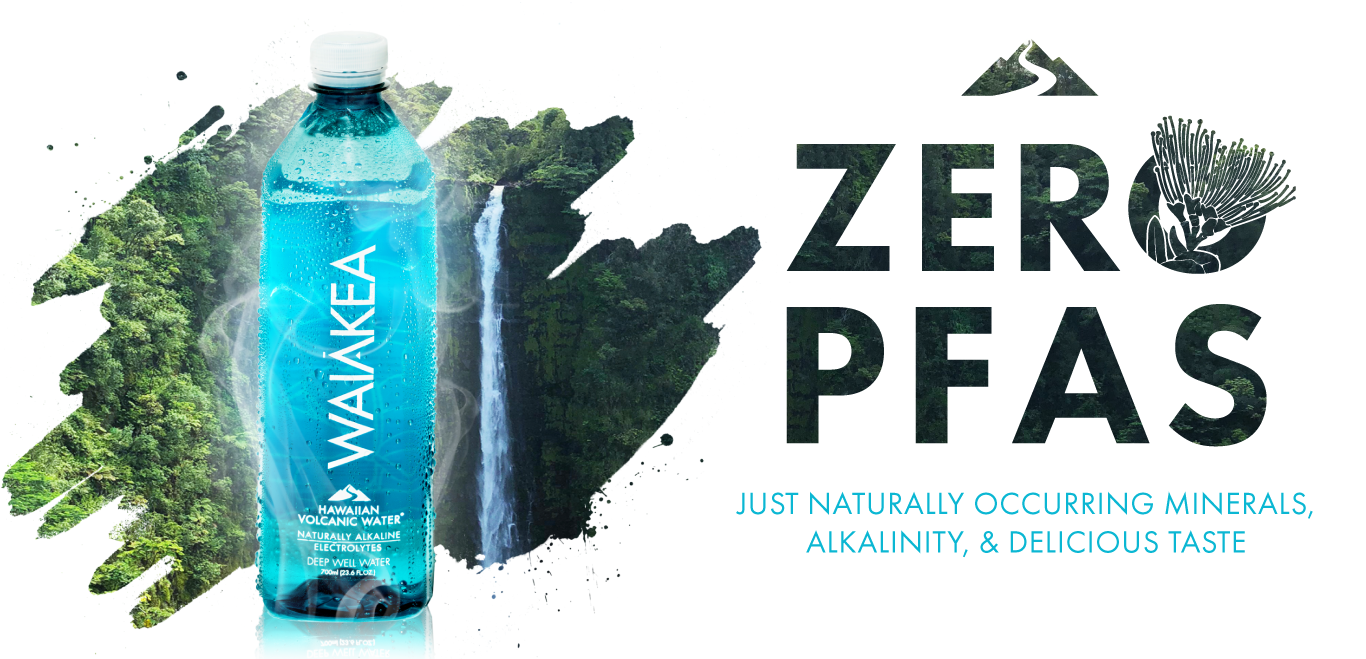It’s known as the toxic “forever chemical” and for good reason. Here’s what you need to know about PFAS in your drinking water.
**Spoiler Alert: Waiākea has NO PFAS in any of its products***

What Are PFAS?
PFAS is a class of about 5,000 different chemical compounds that can be found in many household items, from furniture to clothing, non-stick cookware, cleaning products and fast food packaging.
PFAS is known as the “forever chemical” because of its virtually indestructible nature, meaning it will take a very, very long time for it to go away.
So why is this a problem, you may be asking. Well, testing conducted by the U.S. Agency for Toxic Substances and Disease Registry has found it present in nearly every blood sample they’ve taken. And, the Environmental Working Group (EWG) has published research showing that it's prevalent in our tap water too; more than 2,337 locations in 49 states have drinking water known to be contaminated with PFAS (source).
It goes without saying, no one wants to be drinking water with insidious “forever chemicals” in it, especially when the scientific community is pointing to research that shows a probable relationship between exposure and disease.
What Are The Risks?
A study conducted by the CDC in 2018 has indicated there is a link between 14 different PFAS chemicals and cancer, birth defects, thyroid disease, liver damage, and learning delays in children (source).
Since PFAS came on the radar of health experts and regulatory agencies in 1999, we have slowly but surely learned more about these compounds and their impact on our health. The troubling matter is that we still don’t know much. As put by Cindy Hu, a Harvard data scientist, “If we’re comparing what we know about these chemicals to lead, then I can say lead is more dangerous. If we compare what we know now with what we knew about lead 50 years ago, it’s hard to say which will win” (source).
Why Are PFAS Still Allowed In My Water?
Despite mounting evidence of the danger these forever chemicals pose, we were pretty surprised to discover that the EPA has set no enforceable standards for PFAS limits in drinking water. Instead, they’ve put in place a voluntary limit; 70 parts per trillion, which apply to only two of the forever chemicals— PFOA and PFOS (source).
For many in the scientific community including public health experts and organizations studying PFAS, 70 ppt is exorbitantly high. The EWG recommends no more than 1 ppt in order to be “health-protective”, supported by Harvard environmental health professor Philippe Grandjean, PhD and his 2013 study (source).
So why has the federal government and its regulatory agencies failed to establish standards that would protect U.S. citizens from these chemical contaminants?
The EPA has neglected the issue for over 20 years now. It’s failure to set a national standard for tap water also affects bottled water. Without a limit set by the EPA, the FDA cannot enforce any limits for bottled water brands.
PFAS In Bottled Water
As you can imagine, FPAS are present in many bottled waters, some of the highest levels found in carbonated waters. Topo Chico recently caught a lot of flack, clocking in at 9.76 ppt, the highest of all sparkling waters on the market.

(Source: consumerreports.org)
Does Waiākea Have PFAS?
Nope! Waiākea Hawaiian Volcanic Water has no PFAS in any of its products, including its sparkling and non-carbonated water.
In fact, Waiākea is one of few bottled water brands to have no detectable (ND) levels of PFAS in its still or sparkling water.
Report from Eurofins Eaton Analytical, Inc. ELAP #2813:

This is likely due to the nature and location of Waiākea’s source. Surrounded by forest preserves and isolated from the rest of the world on the Big Island in Hawai'i, Waiākea is lucky to be far away from any activity that could cause PFAS run off.
What Can I Do About PFAS?
Unfortunately, most home water filters aren’t capable of removing PFAS from tap water. There are some larger and more expensive filters on the market however that claim to ‘reduce’ PFAS, such as activated carbon or charcoal filters.
Because of the persistence, mobility, and ubiquity of PFAS in so many household items, it’s virtually impossible to avoid. However, making sure your drinking water is free from PFAS is a great start.
Another easy step is to replace those nonstick pans! A study conducted by The Ecology Center found that 79% of tested nonstick cooking pans were coated with FPAS (source).
Last but not least, contact your local government. States can act faster than federal agencies. Vermont has already set a 20 ppt limit for five PFAS, while New Hampshire passed limits on PFOA (12 ppt) and PFOS (15 ppt).
At the end of the day, we should be asking ourselves why we’re even producing these forever chemicals. Sadly, it's not just the U.S. that is up against this problem, but rather a global issue that we need to start taking seriously.
